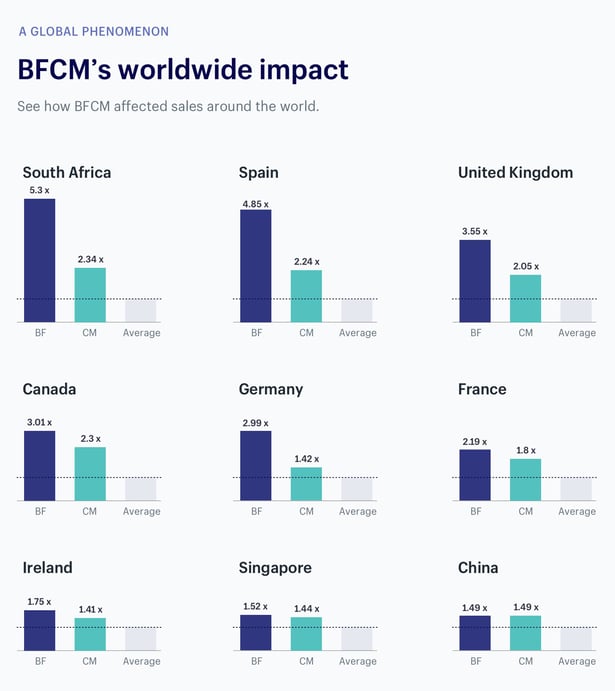To get ready for Black Friday and the start of the winter holiday shopping season, it is crucial for retailers to test their web and mobile applications.
Black Friday's Impact on Sales
Black Friday and Cyber Monday (BFCM) are some of the busiest and most profitable days of the year for many retailers. What started as an American phenomenon is now spreading to other countries including Canada, UK, France, China, Spain, and more with consumers spending billions, online and in-store, purchasing a variety of goods.
A growing trend for Black Friday and Cyber Monday is the growth of e-commerce, especially m-commerce as more shoppers are using their smartphones to make purchases. In 2020, in the U.S. alone, smartphones accounted for 37% of all Cyber Monday sales.
More importantly, mobiles are expected to become the most important driver of e-commerce sales throughout 2021. eMarketer estimates that smartphones will account for nearly 73% of all e-commerce sales.
Given the economic reality, it is vital for retailers to test their website and mobile apps to uncover and eliminate bugs and other anomalies that can reduce conversion rates, lead to a higher cart abandonment rate, crashes, and more.
How to Test E-commerce Apps and Websites?
The key to an effective web or mobile app test is its ability to meet your particular needs. Here, the first step is to define the goals or objectives of the test. This should reflect the particular nature of the site or app as well as the needs of the client. With a clear set of goals in mind, it is easier to design a test that is capable of meeting these goals.
The Ultimate QA Checklist: 7 Steps to Preparing Your Websites and Applications
At StarDust, our clients are accompanied by test analysts and project managers through the planning process to ensure the test is designed to meet the client’s needs. This includes determining what aspects of an app or website to test, which testing methodology is best suited, and which testing devices or configurations are most relevant for the campaign.
E-commerce Test Cases
Testing Updates
It is common for sites and apps to receive an update in anticipation of Black Friday. New banners, pages, links, color schemes, and other elements are often added to attract the attention of online shoppers and redirect them to particular items, information, or pages. When updates include the addition of new functionalities, it is important that they are tested. Failure to do this will make it harder to preserve the quality user experience that you have worked hard to provide.
Load Testing
With higher traffic on Black Friday, it is essential to test your site’s and app’s ability to handle a higher level of traffic. Using your existing traffic data, you can establish a baseline for a load test to assess how much traffic can be handled before the platform’s performance declines and/or crashes. By executing load tests, retailers can improve the stability of web and mobile applications and avoid major problems on Black Friday and other peak shopping days of the season.
Test Promo Codes and Discounts
Discounts and deals are the heart of Black Friday. Therefore, it is vital to test the checkout page to make sure that the discounts and promo codes are properly administered. If not, you run the risk of allowing a bug to disrupt sales leading to frustrated users and lower revenue.
Test the Shopping Cart
The shopping journey (add to cart, checkout, email confirmation, …) must be reviewed several times to make sure it is unperturbed. It would be extremely unfortunate if an “Add to cart” button does not work preventing customers from placing an order online. Overall, tests cases should focus on every aspect of the cart from adding items to the display of error messages when problems do occur.
Regression Testing
Regression testing will verify that updates to your site or app do not result in unintended bugs in other parts of your site or app. This type of testing can be executed manually or via an automated testing script. In either case, it is important to make sure that new updates or iterations to a site or app do not result in new bugs or anomalies that will annoy your shoppers.
Multi-device Testing
Today, more and more people are shopping online using their mobile devices. As a result, it is crucial to execute multidevice testing on websites and apps across a variety of mobile devices, operating systems, and different browsers. Having a large test coverage is key to uncovering any bugs or problems that can be traced to the fragmentation of the smartphone market. Multidevice testing is the best way to ensure that your site or app appears and performs as expected for the greatest number of shoppers.
Test Bug Fixes
At the end of a test campaign, your development team will be busy with bug fixes that will undoubtedly improve your site or app. Nonetheless, it is beneficial to verify the bug fixes. This can be done by retesting the affected elements or by retesting the entire site to ensure the proper corrections have been made.
History repeats itself so it's safe to say that some sites and apps will crash as a result of Black Friday. Nonetheless, this will cost brands dearly. Avoid this fate by testing your site and app to uncover areas of concern and bugs that can hinder your economic performance.
Want to know more about testing websites? Download our white paper: The Challenges of Testing E-Commerce Sites.








